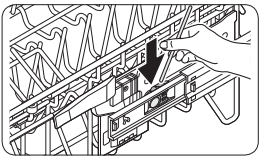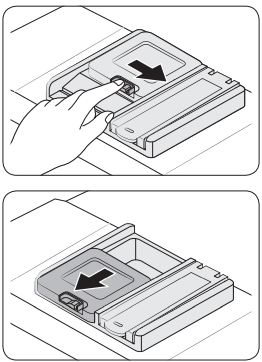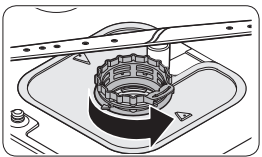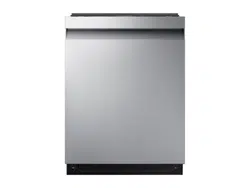Documents: Go to download!
- Owner's manual - (English, Spanish)
- PARTS
- HOW TO USE
- OPERATIONS
- MAINTENANCE
- TROUBLESHOOTING
- INFORMATION CODE
Table of contents
This is User Manual for Dishwasher
PARTS
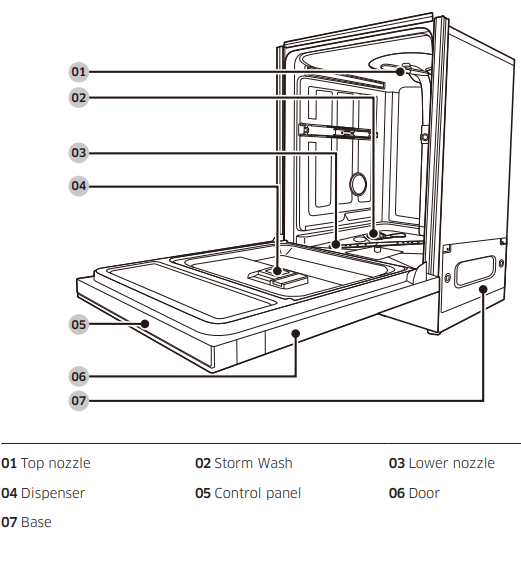
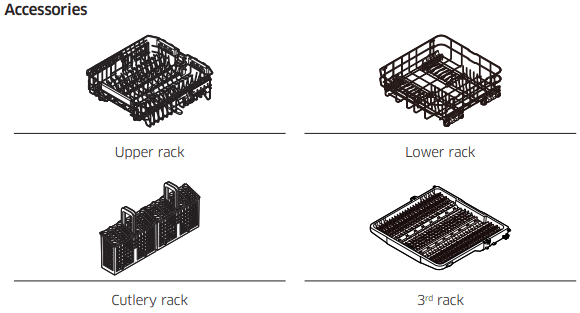
HOW TO USE
Racks
Adjustment
Lower rack: easily fold down the fold-down tines to make room for large items such as pots and pans in the Zone Booster area. Remove the rack from the dishwasher, and then fold down the tines one at a time. See the illustration below.
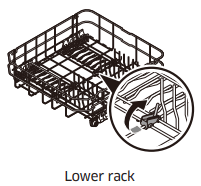
Upper rack: adjust the angle of the tines to three different positions to match the size and shape of your dishes. To adjust the tines, grasp the handle at the front of the rack, and then push it left or right. See the illustration below.

Height Adjustment:
Depending on where you set the upper rack height, the lower rack can accommodate plates up to 12 in. (30 cm) in diameter and the upper rack can accommodated plates up to 8 in. (20 cm) in diameter.
- To raise the upper rack Pull the upper rack upwards. The adjustable handle will latch, and the upper rack will rise.
- To lower the upper rack Hold both the adjustable handles located at the left and right sides of the upper rack, and then evenly press down.
*CAUTION
• Adjust the height of the upper rack before loading dishes into the rack. Adjusting the rack after loading the dishes may damage the dishes.
• Make sure to hold both handles when adjusting, or the dishwasher door may not close properly.
Remove racks
To remove the upper rack
|
|
1. Push the hook on the left rail holder and then the right rail holder. | |
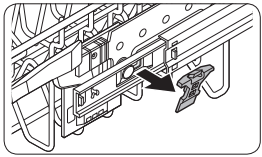 |
2. Remove the rail holders from the left and right rails. |
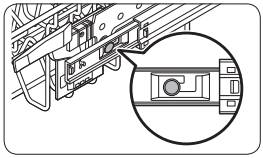 |
3. Check the position of the shaft (dark grey in the illustration) on the rail bracket. | |
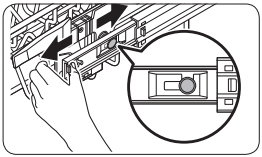 |
4. Slide the upper rack so that the shaft is positioned at end of the rail bracket. |
 |
5. Lift the upper rack to remove. 6. Reverse the order of removal to reinsert the upper rack. |
*CAUTION
- Do not operate the dishwasher without the upper rack. Otherwise, noises occur and the dishwasher does not operate properly.
- Because the upper rack is removable, insert the upper rack properly to ensure the dishwasher operates normally.
- Take care that you do not lose the holder rails during this process.
To remove the 3rd Rack
|
|
1. Stand facing the dishwasher, and then pull the 3rd rack out so that the handles at the ends of the rack supports (dark grey in the illustration) are even with the end of the rack. 2. With your right thumb, find the small indentation on the inside of the left rack support that houses the tab for the handle lock. 3. Push the handle lock tab in (i.e. to your left) with the tip of your thumb, and then pull the handle towards you until it disengages from the support. 4. Repeat this process with the right handle using your left thumb. |
|
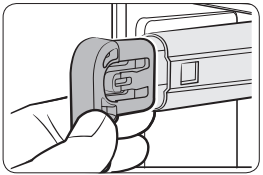 |
5. When the handles are removed, remove the 3rd rack from the dishwasher. |
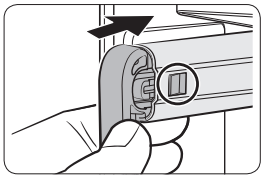 |
6. Reverse the order of removal to re-insert the 3rd rack. *CAUTION Make sure the hook-shaped part of the handle faces downward and the handle lock (circled) re-engages when reinserting the handle into the rail. |
Loading dishes
- Lower rack: designed for dinner dishes, soup bowls, plates, pots, lids, casserole dishes, and plates
Load large items such as pans and pots into the dishwasher so their open sides face downwards. We recommend loading cups, stemware, and small plates into the upper rack. See the recommended loading patterns below

- Storm Wash Area: on the left side of the lower rack, designed to load large items
When you select Storm Wash, the dishwasher supplies additional power to reinforce the water jet in the Storm Wash area. Make sure pot handles and other items do not interfere with the rotation of the nozzles.
- Upper rack: designed for small plates, mugs, glasses, and plastic items marked “dishwasher safe”.
Load your plates into the dishwasher in two half rows, so that the front of each plate faces the back of the plate in front of it, and the open sides of the plates at the center of the dishwasher face each other.
- Glass support:
|
|
The glass support is especially suited for wine glasses. Hang wine glasses onto the pegs of the glass support. Fold the glass support back when it is not being used. *CAUTION Do NOT adjust the level of the upper rack with the glass support propped up. This will make it impossible to adjust the upper rack. |
- The 3rd rack: is best suited for flatware and cooking or serving utensils. You can place cutlery and utensils randomly or regularly on the cutlery rack.
- Cutlery rack: consists of two compartments. You can place each knife, spoon, or fork separately into the spoon stands in the basket’s covers to prevent chipping and discoloration. See the illustrations below. You can use the cutlery rack with the cover open. Refer to the illustration on the left.
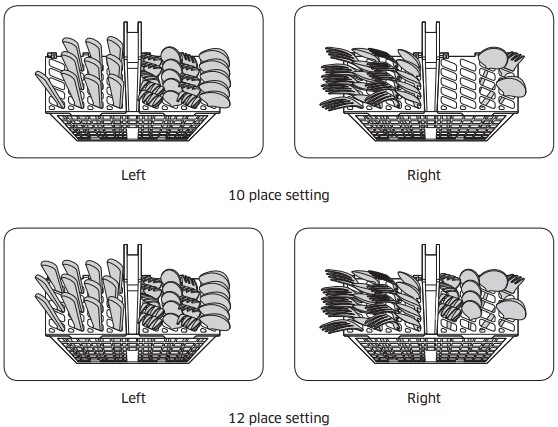
*NOTE: DO NOT let any item extend through the bottom
Detergent
All dishwasher cycles require detergent in the detergent compartment. Apply detergent as appropriate for the selected cycle to ensure best performance.
*WARNING
• Do not consume dishwasher detergent. Avoid breathing in detergent fumes. Dishwasher detergent contains irritants and caustic chemicals that can induce respiratory conditions. If you have consumed dishwasher detergent or inhaled detergent fumes, seek medical attention immediately.
• Keep dishwasher detergent out of children’s reach.
*CAUTION
Use dishwasher detergent only. Other types of detergent produce excessive foam, which may decrease the dishwasher’s performance or cause it to malfunction.
Fill the detergent dispenser
|
|
1. Gently press the dispenser flap to unlock, and then slide it open. Note that the dispenser flap opens at the end of each cycle. | |
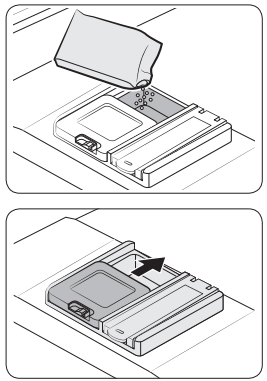 |
2. Apply the recommended amount of detergent to the main compartment. 3. Close the flap, and then press down to lock. *NOTE This dishwasher has no separate compartment for tablet detergent. |
 |
4. For better performace, pour a small amount of detergent onto the door to clean heavily soiled items more effectively. The additional detergent will activate during the pre-wash process. |
The cover opens automatically to dispense the detergent during the wash. Recommended amount of detergent as below.

Rinse aid
Rinse aid improves the drying performance of the dishwasher. When the Rinse Refill indicator lights up on the control panel, refill with rinse aid. Only use liquid rinse aid. Powdered rinse aid will clog the compartment opening and cause the dishwasher to malfunction.
*CAUTION
• Do not apply any type of detergent to the rinse aid compartment.
• Do not over fill the compartment. Excessive rinse aid may overflow during a cycle.
|
|
1. Pull up the cap of the rinse compartment to open. | |
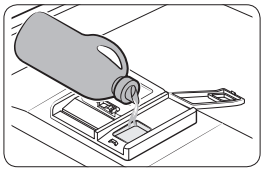 |
2. Fill the compartment with rinse aid as specified by the rinse aid manufacturer. |
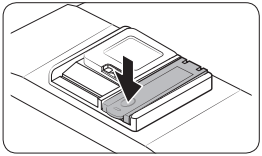 |
3. Press down the circle area of the cap to close. |
Touchpad responsivenes
To prevent the touch-enabled controls from losing responsiveness, follow these instructions.
• Touch the center of each button with one finger.
• Do not touch more than one button at a time, except as directed.
• Clean the surface of the control panel regularly with a soft, damp cloth.
OPERATIONS
Control Panel

| 01 POWER | When you press the POWER button, the Cycle On light for the most recently started cycle turns on. When the selected cycle is complete, the dishwasher powers off automatically. |
| 02 Cycle Selector | Select the appropriate wash cycle depending on the soil level of your dishes. After you select a cycle, the Cycle On light for that cycle lights. If you want to change the cycle once it has started, press the POWER button. Then, turn on the dishwasher again and select a new cycle. |
| 03 Lower Rack | If selected, only the lower rack nozzle is activated to reduce both the cycle time and power consumption. Use this cycle to wash a small load of dishes or glasses in the lower rack. To wash heavily soiled items, select the Storm Wash option. |
| 04 Storm Wash | Use this option when you want to wash pots and pans, durable serving bowls, and other large, very dirty, hard to clean dishes. To use Storm Wash, place the dishes face down in the marked Storm Wash area in the lower basket. |
| 05 Hi-Temp Wash | Raises the main wash temperature to improve cleaning for loads containing tough, baked-on food. |
| 06 Sanitize/ Control Lock |
With the Sanitize option selected, the water temperature is increased to 163 ˚F (73 ˚C) in the final rinse cycle for high temperature sanitization. If you select the Sanitize option, the "Sanitize" lamp blinks when the water temperature reaches the sanitary temperature (over 155 ˚F (68 ˚C)), and then remains illuminated until the Sanitize option ends. When you open the door or press the POWER button, the "Sanitize" lamp turns off. *NOTE: The Normal cycle with the Sanitize option selected is NSF Certified and operates in accordance with NSF/ANSI Standard 184 for Residential Dishwashers. Certified residential dishwashers are not intended for licensed food establishments. Your dishwasher is NSF Certified. Control Lock allows you to lock the buttons on the control panel so children cannot accidently start the dishwasher by pressing the buttons on the panel. To lock and unlock the buttons on the control panel, hold the Sanitize button down for three (3) seconds when the power is On. |
| 07 Display Display | Displays information about the current cycle including the cycle time, remaining time, Delay Start settings, and other cycle-specific information. If a problem occurs during operation, an information code appears with a warning sound. Refer to the control panel code at ending pages. |
| 08 Delay Start |
Delay a cycle for up to 24 hours in one-hour increments. To increase the delay start time, press or hold the Delay Start button. The hour displayed indicates the time at which the wash will start. - After setting the delay time, press the START button, and then close the door to start the cycle. - To change the delay time after the dishwasher has started, first turn the dishwasher off and turn it back on. Then, select a new cycle and change the delay time settings. |
| 09 START |
To start a cycle, press the START button before closing the door. Cancel & Drain: To cancel a currently running cycle and drain the dishwasher, press and hold the START button for three (3) seconds. Once the dishwasher is reset, select a cycle and option, and then press START to restart the dishwasher. |
Indicator displays
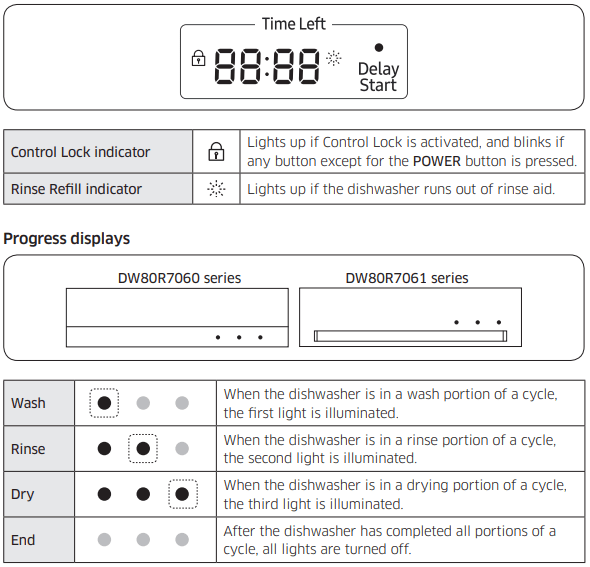
Cycle overview
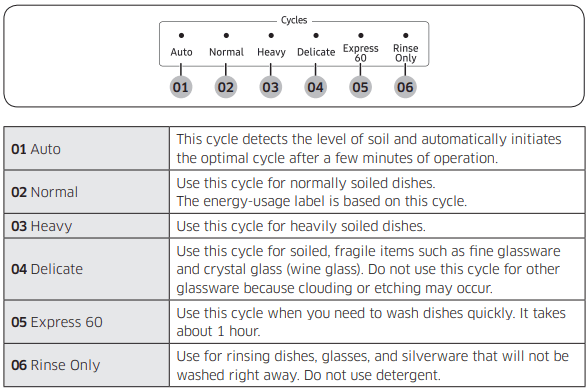
Settings
You can change the sound, Auto Release™ Dry alert, Rinse aid amount, and Auto Release™ Dry settings to your preference. To change the settings, press the Sanitize and Delay Start buttons simultaneously for 3 seconds. Press Sanitize to navigate through the sub menus, and then press Delay Start to confirm your changes.
Sound
Press Sanitize until ‘U1’ or ‘U0’ is displayed. To mute the dishwasher, select ‘U0’, and then press Delay Start. To unmute, select ‘U1’, and then press Delay Start.
Auto Release™ Dry alert
You can enable or disable the setting that alerts you when the door opens to start the Auto Release™ Dry function.
Press Sanitize until ‘J1’ or ‘J0’ is displayed. To disable the Auto Release™ alert, select ‘J0’, and then press Delay Start. To enable, select ‘J1’, and then press Delay Start.
Rinse aid amount
Press Sanitize until ‘F1~F6’ is displayed. The higher the number, the more rinse aid the dishwasher uses. To improve drying performance, select a higher number.
If your dishes appear discolored after a wash, switch to a lower number. The factory default level is ‘F4’.
Auto Release™ Dry
The Auto Release™ Dry function, which is designed to improve drying performance, automatically opens the dishwasher’s door 5 to 15 minutes before a cycle ends.
You can enable or disable Auto Release™ Dry in two ways: Using the Setting Mode or using the toggle keys. Both methods are described starting below.
- Press Sanitize until “A1” or “A0” is displayed. Then, press Delay Start to enable (A1) or disable (A0) Auto Release™ Dry.
- Using the Toggle Keys : Press the Lower + Hi-Temp Wash button for 3 seconds to enable (A1) or disable (A0) Auto Release™ Dry.
*NOTE
• Once the door opens on the Auto Release™ Dry mode, the door cannot be closed manually for the next 2 minutes.
• Disabling (A0) “Auto Release™ Dry” can affect the drying results. Enable (A1) “Auto Release™ Dry” for better drying result.
• After a cycle is complete, the door automatically opens to let steam out. This is normal and not a product malfunction.
Special Features
Delay Start
You can delay the cycle starting time up to 24 hours in 1-hour increments. To increase the delay time, press Delay Start. The hour displayed indicates the time at which the cycle will start.
1. Open the door, and then load the dishwasher.
2. Press Delay Start, and then press or hold Delay Start to change the time in 1-hour increments.
3. Close the door, and then press START.
*NOTE:
To change the delay time once the dishwasher has started, press POWER and then restart the dishwasher.
Touch Controls
Touch controls allow you to operate the dishwasher easily.
• They are convenient to operate, requiring only a soft touch.
• Have a simple and stylish design.
• Are easy to clean.
*NOTE:
If you have children or you want to clean the Control Interface, we recommend activating the Control Lock feature to lock the control buttons.
Control Lock
To prevent children from playing with the dishwasher, Control Lock locks all button controls except for POWER.
• To activate Control Lock, press and hold Sanitize for 3 seconds. With Control Lock activated, you cannot select a cycle or option, or start an operation.
• To deactivate Control Lock, press and hold Sanitize again for 3 seconds.
• Control Lock remains active after the dishwasher restarts. To cancel Control Lock, you must deactivate it first.
MAINTENANCE
Cleaning
Nozzles
Upper nozzle
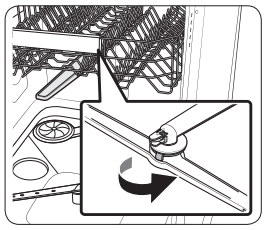
1. Open the door, and then pull out the upper rack to reveal the upper nozzle.
2. Turn counter clockwise to remove the nozzle cap, and then remove the nozzle.
3. Unclog and clean the nozzle.
4. Reinsert the nozzle, and then tighten the cap clockwise.
5. Rotate the nozzle by hand to make sure the nozzle is engaged correctly
Top nozzle
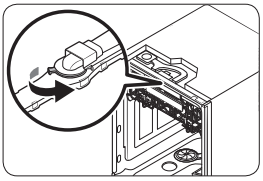
1. Check whether the nozzle holes are clogged by food particles.
2. If cleaning is needed, remove the top nozzle.
3. To remove the top nozzle, pull out the upper rack first, unfasten the nozzle cap by turning it counterclockwise, and then remove the nozzle.
4. Clean the nozzle, re-insert it, and then fasten the nozzle cap to the nozzle by turning the cap clockwise.
5. Check whether the nozzle is engaged correctly by rotating it by hand.
Lower nozzle
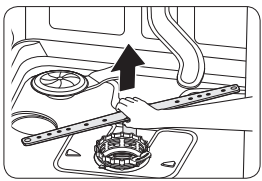
1. Open the door, and then pull out the lower rack to reveal the lower nozzle.
2. Pull up the nozzle to remove it.
3. Clean the nozzle.
4. Re-insert the nozzle, and then push the nozzle down until you hear a click.
5. Rotate the nozzle by hand to make sure the nozzle is engaged correctly.
Filter
We recommend cleaning the filter every month.
|
|
1. Open the door, and then remove the lower rack. 2. Turn the filter handle counterclockwise to unlock the filter cover. |
|
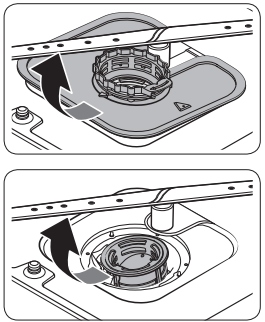 |
3. Remove the filter cover, and then the cylindrical micro filter underneath. |
 |
4. Remove any dirt and impurities from the micro filter and the filter cover. 5. Rinse them with running water, and then dry well. |
|
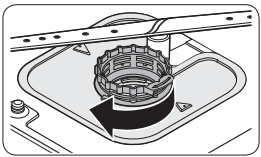 |
6. Reinsert the filter, and then the filter cover. 7. Turn the filter handle clockwise to lock. |
*CAUTION
Make sure the filter cover is closed properly. A loose cover can reduce the filtering performance.
Drain pump
If the dishwasher fails to drain because the drain pump is clogged with foreign matter or there is an abnormal noise coming from the drain pump, you must unclog and clean the drain pump as instructed below.
1. Remove the lower rack.
2. See the "Filter" section to remove the cylindrical micro filter.
3. Remove any moisture from the filter using a sponge.
4. Remove the drain-pump cover by pushing its handle in the direction of the arrow (1), and then pulling up (2).
5. Check the impeller to see if it's in good condition. Then, remove any foreign matter from the pump.
6. Reinsert the drain-pump cover and then press down until you hear a click.
Long-term care
If you will not use the dishwasher for an extended period of time, first drain the unit completely, and then disconnect the water hose. Shut off the water supply valve and the circuit breaker. Water remaining in the hoses or the internal components can damage the dishwasher.
Storing your dishwasher
If you need to store your dishwasher for an extended period of time, first drain and disconnect it. If you leave water in the hoses and internal components, you can damage the dishwasher.
After draining and disconnecting the dishwasher, be sure to turn off the water supply valve and circuit breaker.
TROUBLESHOOTING
Will not start.
- The door is not closed completely.
- Check if the door is latched and closed completely. Check whether the Upper Rack is properly joined to the Duct Nozzle.Also, check if the Upper Rack is crooked or unbalanced.
- The START button was not pressed.
- See the information code that appears on the display.
- Doesn't operate at all.
- Make sure the power cable is connected properly.
- The water supply does not work.
- Check if the water supply valve is open.Check if the supplied water pressure is between 20 and 120 psi (between and 830 kPa).
- The Control Panel is locked.
- Unlock the Control Lock
- A circuit breaker is open
- Reset the circuit breaker
An operation or cycle is taking too long.
- The dishwasher is connected to a cold water supply.
- Check if the water supply line is connected to a cold water supply. To work properly, the dishwasher must be connected to a hot water supply. (If connected to a cold water supply, additional time is required to heat the cold water.)
Food particles remaining on dishes. (Not cleaning properly.)
- The cycle selected was unsuitable
- Select a cycle according to the number and soil level of the dishes, as directed in this manual.
- The water temperature is low.
- Connect the water supply line to a hot water supply. For best performance, the temperature of the supplied water should be 120˚F (49˚C).
- Low water pressure.
- The water pressure should be between 20 and 120 psi (140- 830 kPa).
- The water is too hard.
- Use a commercial dishwasher cleaner.Use high-quality, fresh detergent with rinse aid.
- Dishwasher detergent was not used.
- Use automatic dishwasher detergent.
- We recommend a powder type or multi-function tablet dishwasher detergent.
- Detergent remains in the dispenser.
- Make sure large items such as cookie sheets, cutting boards, or contaners, etc. are not blocking the detergent dispenser and preventing it from opening properly. Rearrange the dishes so they do not interfere with detergent dispenser operation.
- There is no rinse aid.
- Check the dispenser and add rinse aid.Use liquid type rinse aid.
- A nozzle is clogged
- Clean the nozzle.
- The dishes are improperly loaded. Too many dishes have been loaded.
- Rearrange the dishes so they do not interfere with nozzle rotation and detergent dispenser operation.
- Load only an appropriate number of dishes.
- Load your dishes as recommended.
- Load the heavily soiled items into the Storm Wash area.
- The filters are clogged or not correctly fastened. (Food soils remain on the filter.)
- Scrape food from dishes prior to loading. (Do not pre-rinse.)
- Clean the filter.
- Make sure the filters are correctly fastened.
- Less water than required is supplied.
- Check if the supplied water pressure is between 20 and 120 psi (between 140 and 830 kPa).
Leaves glasses with a light film.
- The water supplied is soft and too much detergent was used.
- Underload the dishwasher and use a rinse aid to minimize this.
- Aluminum dishes were included in the wash load.
- Remove the marks on the dishes using a low sensitivity cleaner.
Leaves a yellow or brown film on the inside of the dishwasher.
- This is caused by coffee and tea soils.
- Remove the soils using a spot cleaner. Use a cycle with a higher temperature.
Does not dry dishes well
- There is no rinse aid in the dispenser or not enough rinse aid was used.
- Check the dispenser and add rinse aid.
- Use a liquid type rinse aid.
- Check the rinse aid settings
- The temperature of the water is low when the dishwasher is running.
- Connect the water supply line to a hot water supply.
- Use rinse aid with the Sanitize option
- Too many dishes have been loaded.
- Proper loading of items can affect drying.
- Load your dishes as recommended.
- Glasses and cups with concave bottoms hold water. This water may spill onto other items when you unload.
- After finishing the cycle, empty the lower rack first and then the upper rack. This will prevent water dripping from the upper rack onto the dishes in the lower rack.
- Auto Release™ Dry is turned off.
- Turn Auto Release™ Dry on. Press the Lower + Hi-Temp Wash button for 3 seconds to access the Auto Release™ Dry menu. Select "A1" to activate Auto Release™ Dry.
- Multiple detergent tablets were used without selecting the Sanitize option.
- Select the Sanitize option or use rinse aid.
INFORMATION CODE
- LC: Leakage check.
- If a water supply valve connection leak occurs, close the water supply valve and go to your house circuit breaker panel, set the dishwasher’s circuit breaker switch to off, and then contact the installer to fix.If the problem continues, contact an authorized Samsung service center.
- 4C: Water supply check.
- Check if the water supply valve is closed or clogged, or is frozen. Also check if the supplied water pressure is less than required.If the problem continues, close the water supply valve, and then contact an authorized Samsung service center.
- 5C: Drain check.
- After closing the water supply valve, check whether the drain hose is clogged or folded. Also, check whether the drain hole inside the sump is clogged.If the problem continues, contact an authorized Samsung service center.
- HC: High temperature heating check.
- Functional check. With the dishwasher empty, add detergent, and then run a cycle. If the problem continues, go to your house circuit breaker panel, set the dishwasher’s circuit breaker switch to off, and then contact an authorized Samsung service center.
- 3C: Pump operation check.
- Functional check. Turn off the dishwasher and try to start it again.If the problem continues, contact an authorized Samsung service center.
- PC: Zone wash function check.
- Functional check. Turn off the dishwasher and try to start it again.If the problem continues, contact an authorized Samsung service center.
See other models: DVE54R7200V/A3 NK30R5000WG/AA NA36R5310FS/AA MA-TK3080CT VR1AM7040W9
